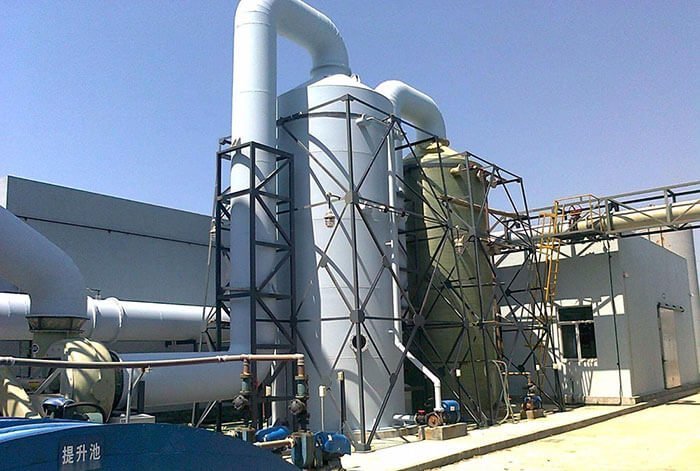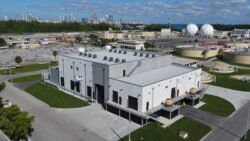H2S Control Equipment and Systems

Communities surrounding industrial facilities and municipal operations are directly impacted by foul orders making life unbearable. These smells indicate more than just the presence of nuisance, but rather hazardous air emissions that pose serious environmental and public health threats. Hydrogen Sulfide (H2S)—one of these contaminants—is a flammable and highly toxic gas that is normally known by its pungent (rotten eggs) stench.
While small concentrations of H2S occur naturally, large volumes are generated from the anaerobic bacterial breakdown of organic materials containing sulfur. Common sources include:
- Sewers
- Wastewater treatment digesters
- Landfills
- Oil and gas production
The Risks of Exposure to H2S
Hydrogen sulfide’s offensive odor is unmistakable at lower concentrations, producing symptoms, such as headaches and nausea. However, higher concentrated doses bring far more severe consequences. At levels as low as 100 ppm, it can cause serious respiratory distress, and just a few breaths around 1000 ppm is potentially fatal. H2S is a silent killer – paradoxically causing a temporary loss of smell that leaves victims unaware of continued exposure risk.
Nearby industrial equipment also falls victim to hydrogen sulfide’s corrosive effects. Concentrated H2S rapidly degrades materials like carbon steel, damaging process equipment, instrumentation, and eventually facility integrity over time. Even relatively low H2S levels of 10-20 ppm can quickly attack copper, zinc, and other key metallic components.
H2S Treatment Methods and Equipment
1. Physical Adsorption
One of the most common approaches utilizes physical adsorption to capture hydrogen sulfide and other contaminants on highly porous media beds of activated carbon or alumina. As the polluted air stream passes through, molecules adhere to the immense surface area until the media becomes saturated and requires regeneration or replacement.
2. Chemical Scrubbing
For higher concentration levels, chemical scrubbing provides more robust H2S treatment using a variety of oxidizing reagents and neutralizing solutions. Chlorine, caustic soda, and other chemical injections selectively convert hydrogen sulfide into either solid precipitates or soluble sulfur compounds for capture and removal. While effective, these wet scrubbing methods incur ongoing chemical costs and produce waste byproducts requiring disposal.
3. Biological Treatment
Biological systems employ naturally-occurring microbes immobilized in reactors or trickling filter beds. These microbial cultures metabolically oxidize H2S into elemental sulfur solids or sulfate solutions that can be easily managed. Biological treatment excels at lower operating costs with minimal sludge production but requires more land space.
4. Thermal & Catalytic Oxidation
When highest treatment efficiencies are mandated, thermal and catalytic oxidation offer another solution by essentially combusting hydrogen sulfide into benign byproducts. Traditional thermal oxidizers heat contaminated air streams to temperatures over 1200°F, converting H2S into sulfur dioxide (SO2) that is further treated. More energy-efficient catalytic oxidation utilizes lower temperatures around 600°F by leveraging specialized catalyst beds. However, both approaches incur significant fuel penalties.
5. Integrated Systems for Optimized Performance
Today’s most advanced H2S control systems blend multiple treatment methods into robust, integrated process configurations. For example, a single facility’s air handling system may incorporate particulate removal, chemical scrubbing for high H2S loads, followed by biological polishing to strip residual trace odors and compounds cost-effectively. Critical supporting equipment like liquid-gas contactors, packed towers, and bioscrubbers enable these multi-stage treatment schemes for optimized performance across challenging conditions.
6. Automation and Monitoring
To maximize reliability and efficiency, these integrated systems leverage the latest process automation, monitoring instruments, and control software to continuously optimize operations in real-time. Sensors measure influent conditions and contaminant levels, automatically adjusting chemical metering pumps, blowers, and other equipment accordingly. Advanced system controls seamlessly interface with centralized control systems, enabling remote monitoring and automated adjustments for truly hands-off operations.
Customized Engineering for Compliance
Strict regulations and health concerns are currently driving the ever-lower permissible emission limits, necessitating the need for specialized engineering support (for industrial and municipal operators) when implementing gas cleaning solutions. Trusted air quality control experts can evaluate each facility’s unique conditions and design tailored hydrogen sulfide removal systems that deliver reliable performance while minimizing operational costs.
Professional air pollution control companies provide turnkey H2S treatment solutions, including system sizing, equipment specification, control programming and long-term service support. These companies combine deep process knowledge with the latest technology advancements, ensuring regulatory compliance through cutting-edge, energy-efficient designs optimized for real-world demands.


